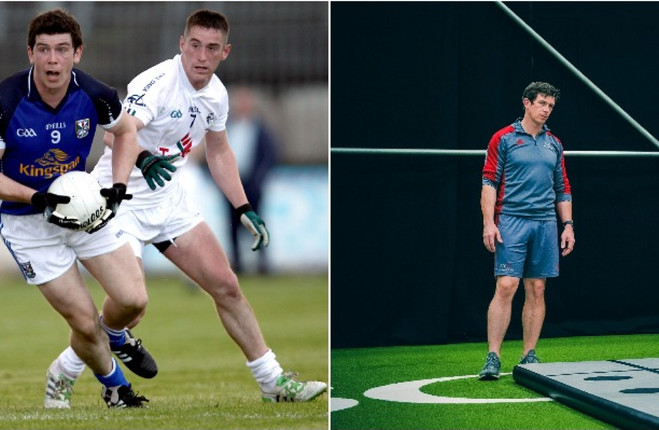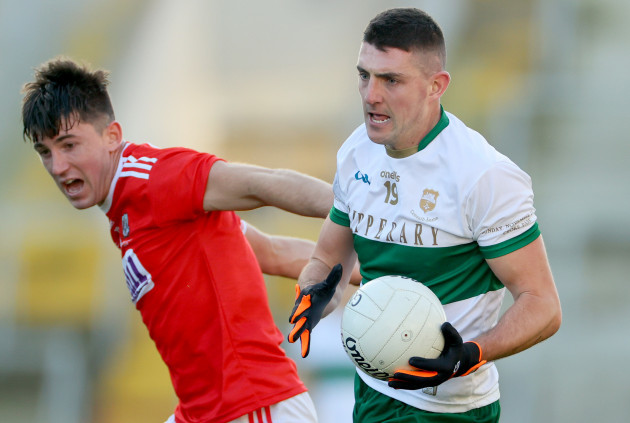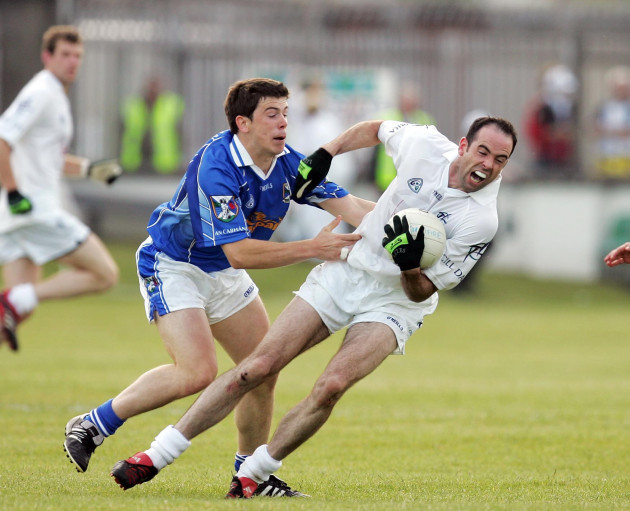IN THE SUMMER of 2018, Tipperary and Sydney Swans flyer Colin O’Riordan came crashing to a halt. He suffered from osteitis pubis as a teenager and in his third year of professional sport it started to flare up again.
O’Riordan persevered until one agonising day at the SCG against the Gold Coast. As he turned to race up the field, the pain became unbearable. At that moment he was convinced his hip was about to explode.
“I couldn’t play the last four games of the season at all,” O’Riordan explained last year.
“I went home and saw Enda King. He had me back running in two weeks. He just sees things differently. Not that he doesn’t believe in surgery but fix the problem before you do that. It was about running mechanics and technique.
“He is honestly incredible. His knowledge of the body. I don’t think he did any work on my groins. It was all hips and glutes. We were doing calf work. I was wondering how this influenced my ability to run. But it does. We’d do a squeeze test and there would be less pain. It is all related.
“He views your body as one. Your upper back is as important as your hips in running. It is all linked. It opened my mind to how the body works. It was like going to college for five weeks.”
This endorsement came to mind recently when reading Chloe Mustaki describe her remarkable recovery from Hodgkin’s lymphoma and an ACL injury. The physical and emotional toll was considerable. During her first visit with King, Mustaki broke down in tears of frustration. It was seven months since her surgery and the pain had not subsided. Fears about never recovering had started to creep in.
Last month she made her Ireland debut.
“This is one of the best parts of my job. It is nice to help good people,” says King.
He has been working as the Head of Performance Rehabilitation at the Sports Surgery Clinic in Santry, Dublin for the past decade. There he has worked with the likes of Johnny Sexton, Ruby Walsh and Dan Carter as well as a host of professional clubs across sports from the Premier League, NBA and the AFL.
“Going back to my own career and injuries, it can feel like a crater. When you are in it and you’re not sure if anyone can help you get out of it, you cling to any light at the end of the tunnel.
“My goal is to help them understand why they are where they are, but it is also to give them some direction and that they feel empowered to stick to it rather than wait for it to get better. I am not at the level of Chloe or Colin and never was, but any footballer knows what it is like to sit in that chair and wonder will I ever be right.
“Most chronic or recurrent injuries do not go away. You have to get rid of them. People are waiting for it to go away and naturally you become despondent. Whereas a broken bone has a defined recovery and timeline and it gets better. Having been through those experiences, from a research and biomechanics point of view, really opened my eyes.
“Moving attention away from where you are sore and focusing on why you are injured. Then trying to get that across to an athlete. Ultimately, they are doing all the work. I am just trying to show them the direction.”
King’s own playing days influenced his approach now. He still draws on it. He was moulded by it. After success with his club Cavan Gaels, the midfielder went into an intercounty squad with dreams of Ulster glory. Meanwhile, his hip and groins gave him nightmares.
The same thing that hindered him on the field allowed him to prosper professionally.
“At the time, you want it to be fixed rather than standing back and wondering why it is happening. Training load is naturally a massive factor in most overuse injuries. You want to contribute to every team, all the time, rather than focusing attention and saying, developmentally I want to play at this level.
“What can I do this year to achieve that? You try to be a servant to everyone and end up pleasing no one.
“When I look back, rather than looking for a fix or anti-inflammatories or surgery, the first question is why am I sore in this area? How can I optimise my training load and how I move on the field of play to give me the best chance of staying injury-free and optimise my athletic performance.
“Then it is about how do I do it as an athlete? For example, the idea of being in a gym is to make you a better athlete on the field. Not to be only better in the gym.”
Knowing what you want and the best way to attain it. That is his creed and the bedrock of his work. When athletes present with pain, the first step is not targeting the painful area alone but understanding why it is there.
His PhD research focused on the use of 3D biomechanical analysis to better understand how an athlete moves, how that is driving their injury and how to individualise their rehab based on their specific deficits.
Soreness is not just to be dismissed or suppressed with a short-term fix. King rarely uses injections or anti-inflammatory during groin rehab. Pain is a useful marker. A signal providing valuable information. It is about understanding the source rather than temporarily quelling it.
Thanks @KThorborg greatly appreciate your input and in particular @gaelicplayers for their work and support in carrying out research in this area to improve our understanding of the problem to improve player welfare @TomParsons_8 @eamomurph @Begz_17 #groin #hip #FAI #GAA https://t.co/FcL0GUyHHI
— Enda King PhD (@enda_king) February 3, 2022
He recently published a research study on hip and groin pain prevalence and prediction in Elite Gaelic Games. It monitored 2703 male athletes across two seasons, the largest study in elite athletes relating to hip and groin pain internationally. The findings were presented at the IOC conference in Monaco last year.
Such research has led to a seismic shift in rehab strategies. Yet the injuries keep happening. How are we improving one crucial aspect while stagnating in the other?
“That paper shows at least 40% of every intercounty team male squad will have athletic hip and groin pain every season, which is a substantial amount,” he explains.
“When you look at why people develop groin pain, it is also about how they move, and the amount of load placed on the body.
“Our understanding of how it manifests in terms of how we move has greatly improved. It has certainly been a game-changer from a rehabilitation point of view.
“But the one thing that has remained constant is the high training loads. The body is meant to train hard. That is not the problem. It is the fact that some things changed tremendously, and some haven’t changed at all. Look at the window from December to March and the demands on young players across several different squads. It is a recipe for groin pain.
“Our ability to rehab these athletes is improving all the time, our understanding and focus on their anatomy, not sending everyone for surgery but fundamentally it is still underpinned by a need to have sufficient periods of recovery within the week and to have sufficient periods of recovery within the season.
“You can’t be a servant to multiple teams at one time.”
Much done, more to do. After 15 years in Santry, the Cavan native is about to bid farewell and take a new role as Head of Performance and Development for the Orthopaedic and Sports Medicine Hospital in Aspetar, Qatar.
The plan is to swap Dublin for Doha while continuing to work with visiting athletes and travel internationally to assist teams. The chance to work at a FIFA-accredited world-renowned centre of excellence was too good to pass up.
“My role is assisting in the rehabilitation of elite athletes. Both in Qatar and with international athletes visiting. Whether that is players from teams they are affiliated with, such as PSG, or injured athletes I work with, or teams coming for warm-weather training and preparation for the World Cup.
“Obviously, they are connected to PSG, so you have Neymar, Messi, Mbappé etc. I am looking forward to working with that type of athlete and bringing my experience from the SSC with me to contribute to clinical practice and research.
“I will also be assisting the development of their multidisciplinary team. As an international centre of excellence, they highly prioritise that clinical consistency. Trying to put structures and ongoing research pathways in place with a continuity of care at the highest level.
“My attraction to working with elite athletes has always been that it is a fantastic environment to develop yourself clinically. To work with one athlete for five or six hours a day, you can really get into a depth of analysis. Get them from A to B as quick as possible.
“It allows you to take that expertise and share it with colleagues. One of the fantastic things about the SSC was providing elite athlete care for all.
“Take the principles you are applying to a high-level athlete and use that to apply a precise but modified version to the general population. You develop clinically and can have the most impact in terms of pushing understanding.”
Mining the smallest details generates the greatest lessons. That is at the heart of everything King does. Small brushstrokes without ever losing sight of the big picture. The goal is to rehab athletes. If implemented correctly that should ensure they improve as athletes.
“That is the starting point. The day one conversation is where are you sore, why are you sore, what are we going to do about it?
“If you run this way and do this, your performance will also improve. Everyone is great at rehab when they are injured and terrible when they are not injured. How can you get the buy-in that athletes are constantly developing?
“Great athletes like Colin keep in touch not just when injured but because they want to get even better. That is the whole point. Giving you what you need to rehabilitate your injury but also make you a better athlete.”



